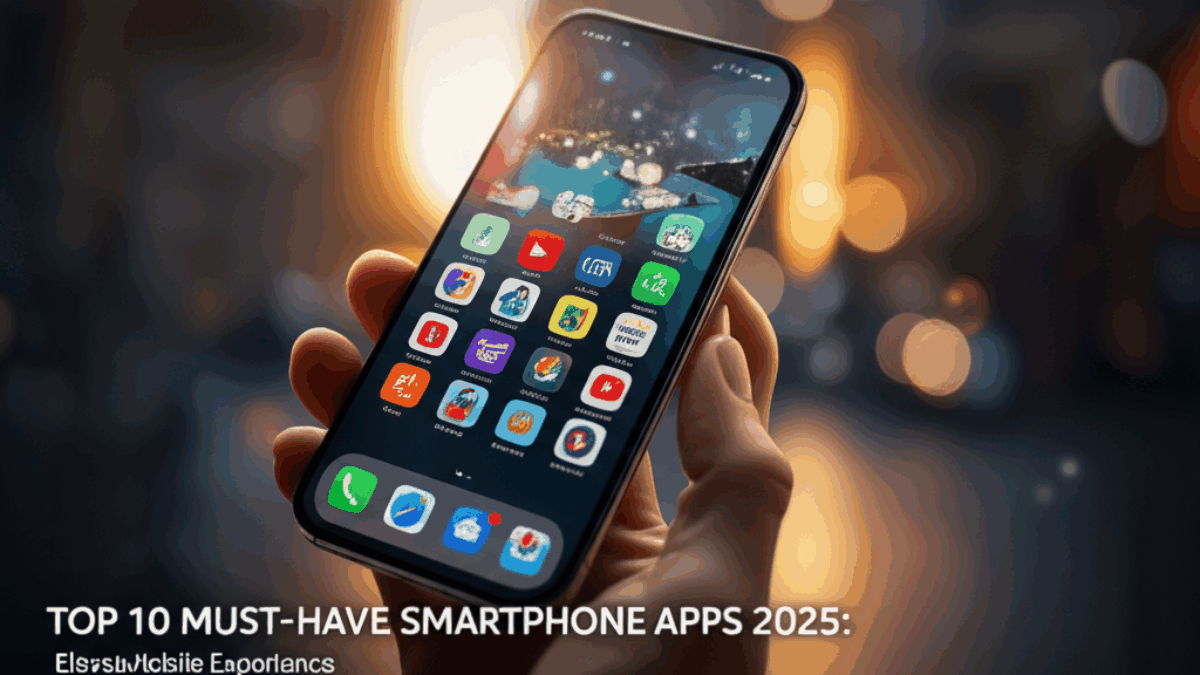Smartphones have become indispensable tools in our daily lives. From communication and entertainment to productivity and health, these devices are more than just gadgets; they are lifelines connecting us to the world. As we embrace 2025, the mobile app ecosystem continues to evolve at breakneck speed, offering innovative and powerful solutions that enhance our experiences.
This article explores the top 10 must-have smartphone apps of 2025, providing insights, comparisons, and recommendations to help you optimize your mobile device. Whether you’re a student, a busy professional, or a gaming enthusiast, there’s something here for everyone.
The Rising Trend of Smartphone Apps
Why are smartphone apps trending? The answer lies in their integration into our everyday lives. With an estimated 7 billion smartphone users globally, the demand for high-quality applications has surged. The COVID-19 pandemic catalyzed a digital transformation, prompting users to rely on these apps for education, work, and social interaction. As we move forward, the evolution of AI, AR, and internet connectivity will further enhance app functionality and usability.
Innovative apps are no longer just a convenience; they’re essential for efficiency, productivity, and entertainment. The selection of apps available in app stores grows increasingly diverse, helping users find tailored solutions that fit their unique lifestyles.
Key Features to Look For in Mobile Apps
When assessing which apps to incorporate into your smartphone, consider the following key features:
1. User Interface (UI) & User Experience (UX)
A well-designed app should be intuitive and easy to navigate. The visual aesthetics, layout, and ease of use directly impact user satisfaction. An app that is cluttered or confusing can deter users from fully utilizing its features.
2. Performance & Speed
Fast-loading apps enhance the user experience and ensure that you aren’t left waiting. Look for apps with low memory usage and minimal lag, especially when you’re handling multiple tasks or using resource-intensive features.
3. Functionality & Integration
An app should not only serve its primary purpose but also integrate seamlessly with other applications. Many users prefer apps that sync with their devices and services, such as calendars, productivity tools, and cloud storage.
4. Security & Privacy
Data security is paramount, especially with the rise in cyber threats. Look for apps that include robust security features like end-to-end encryption, regular updates, and transparent privacy policies.
5. Customization & Personalization
Personalization features allow users to tailor their experience. This might include themes, settings, and tailored recommendations that adjust based on user behavior.
6. Offline Capability
While connectivity is increasing, offline functionality remains essential, especially for users in locations with limited internet access. Apps that allow offline access can be invaluable for travel and work.
Top 10 Must-Have Apps for 2025
Here’s a detailed rundown of the top 10 must-have smartphone apps, along with pros and cons, tailored for different users.
1. Evernote
- Category: Productivity
- Platform: iOS, Android
-
Key Features:
- Note-taking with rich formatting
- Integrated calendar
- Task management features
- Cloud synchronization
Pros:
- Intuitive interface.
- Multi-device sync.
-
Supports multimedia notes (voice, images).
Cons:
- Premium features require a subscription.
- Limited offline access without premium.
Use Case:
Ideal for students and professionals who need to organize notes, assignments, or projects.
2. Notion
- Category: All-in-One Workspace
- Platform: iOS, Android, Web
-
Key Features:
- Database and spreadsheet functions
- Task and project management
- Collaboration features
Pros:
- Highly customizable.
- Excellent for team collaboration.
-
Built-in templates for effortless setup.
Cons:
- Steeper learning curve for beginners.
- Requires consistent internet for best use.
Use Case:
Perfect for teams and organizations managing complex projects.
3. Figma
- Category: Design & Prototyping
- Platform: Web, iOS, Android
-
Key Features:
- Collaborative design tool
- Cross-platform support
- Prototyping features
Pros:
- Real-time collaboration.
- Intuitive and rich design tools.
-
Extensive community and resources.
Cons:
- Performance can lag on low-end devices.
- Limited offline capabilities.
Use Case:
Essential for graphic designers and UX/UI professionals.
4. Slack
- Category: Communication
- Platform: iOS, Android, Web
-
Key Features:
- Channels for team communication
- Integration with apps like Google Drive
- File sharing and collaboration tools
Pros:
- Facilitates organized communication.
- Video and voice calls included.
-
Customizable notifications.
Cons:
- Can become overwhelming with many notifications.
- Free version limits access to past messages.
Use Case:
Great for workplace communication and project teams.
5. Duolingo
- Category: Education
- Platform: iOS, Android
-
Key Features:
- Gamified language learning
- Progress tracking
- Offline learning available
Pros:
- Engaging learning format.
- Covers a wide range of languages.
-
Free and premium options.
Cons:
- Limited depth for advanced learners.
- Some ads in the free version.
Use Case:
Ideal for students and travelers looking to learn new languages.
6. Trello
- Category: Project Management
- Platform: iOS, Android, Web
-
Key Features:
- Kanban-style boards
- Task assignment and due dates
- Integration with other apps
Pros:
- Visual task management.
- Simple and effective UI.
-
Perfect for team collaboration.
Cons:
- Limited features in the free version.
- Can be cumbersome for complex projects.
Use Case:
Suitable for teams managing workflows and projects.
7. Spotify
- Category: Music & Entertainment
- Platform: iOS, Android
-
Key Features:
- Extensive music library
- Personalized playlists
- Offline listening option
Pros:
- Rich catalog of podcasts, playlists, and albums.
- Highly personalized recommendations.
-
Social sharing features.
Cons:
- Free version has ads.
- Download limits on the free version.
Use Case:
A must-have for music lovers and podcast enthusiasts.
8. Headspace
- Category: Health & Wellness
- Platform: iOS, Android
-
Key Features:
- Guided meditations
- Sleep sounds and exercises
- Mindfulness techniques
Pros:
- User-friendly interface.
- Diverse meditation practices.
-
Excellent for stress relief.
Cons:
- Subscription cost for full access.
- Free version has limited content.
Use Case:
Best for individuals seeking mental health and wellness resources.
9. Zoom
- Category: Video Conferencing
- Platform: iOS, Android, Web
-
Key Features:
- HD video and audio calling
- Screen sharing options
- Multi-device access
Pros:
- High-quality video conferencing.
- Extensive features for meetings.
-
User-friendly setup.
Cons:
- Stability issues on low-bandwidth networks.
- Free version has time limits on group calls.
Use Case:
Essential for remote workers and virtual meetings.
10. Strava
- Category: Fitness Tracking
- Platform: iOS, Android
-
Key Features:
- Track running and cycling
- Route discovery
- Community features for motivation
Pros:
- Robust tracking features.
- Social community for accountability.
-
Easy to use.
Cons:
- Premium features require a subscription.
- Privacy concerns with shared data.
Use Case:
Perfect for fitness enthusiasts and athletes.
Expert Recommendations: Budget vs. Premium Choices
When choosing apps, balancing functionality with cost is essential. Here are some budget-friendly and premium recommendations.
Budget Choices
- Evernote (Free version)
- Duolingo (Free version)
- Strava (Free with basic tracking)
Premium Choices
- Notion (Affordable subscription for teams)
- Figma (Industry-standard for professionals)
- Headspace (Comprehensive wellness resource)
Conclusion
Maximizing your smartphone experience in 2025 is all about finding the right apps that suit your lifestyle. The best apps are not just tools; they are companions that enhance daily activities, streamline tasks, and provide entertainment and education.
FAQs
1. How do I choose the right apps for my needs?
- Assess your daily activities and identify tasks that could be streamlined or enhanced by technology.
2. Are free apps worth downloading?
- Many free apps have limited features, but they can still offer significant value. Exploring them first can help you find out if you want to invest in a premium version.
3. Can I use multiple apps for the same purpose?
- Absolutely! Different apps often provide unique features, so using multiple options can maximize your efficiency.
Buyer’s Checklist
- [ ] Clear understanding of my needs
- [ ] Research and read reviews
- [ ] Check for free trial options
- [ ] Ensure compatibility with my device
- [ ] Look for data privacy and security measures
In a world where smartphones are integral to our lives, having the right apps can transform how we communicate, work, learn, and relax. With this guide, you’re well-equipped to navigate the vibrant app landscape of 2025 and capitalize on the innovations it brings. Happy downloading!

